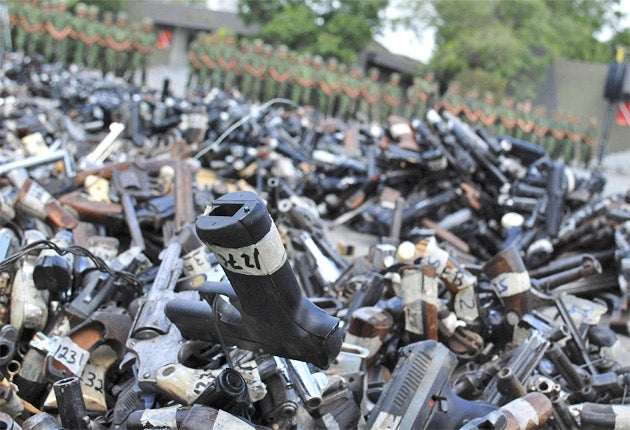Your support helps us to tell the story
From reproductive rights to climate change to Big Tech, The Independent is on the ground when the story is developing. Whether it's investigating the financials of Elon Musk's pro-Trump PAC or producing our latest documentary, 'The A Word', which shines a light on the American women fighting for reproductive rights, we know how important it is to parse out the facts from the messaging.
At such a critical moment in US history, we need reporters on the ground. Your donation allows us to keep sending journalists to speak to both sides of the story.
The Independent is trusted by Americans across the entire political spectrum. And unlike many other quality news outlets, we choose not to lock Americans out of our reporting and analysis with paywalls. We believe quality journalism should be available to everyone, paid for by those who can afford it.
Your support makes all the difference.A botched experiment that saw US law-enforcement agents allow shipments of illegally purchased firearms to be smuggled into Mexico, where they were promptly used in violent crimes, has been described as "the perfect storm of idiocy" in a congressional report.
More than 2,000 weapons were allowed to "walk" from the gun-shops of Texas and Arizona during the intelligence operation, which was carried out in 2009 and 2010 and dubbed "Fast and Furious" by its gung-ho overseers at the Bureau of Alcohol, Tobacco, Firearms and Explosives [ATF].
So far, just over 500 have been recovered, leaving 1,500 still at large. Around 122 guns, largely AK47 and .50 calibre sniper rifles, have now been found at crime scenes. Two were left near the body of Brian Terry, a US border patrol agent killed in December by suspected smugglers in the Arizona desert.
The report, released in Washington yesterday by the House Committee on Oversight and Government Reform, contains criticism of Fast and Furious, which was carried out despite objections from street-level ATF agents who believed it would inevitably lead to a bloodbath.
It reveals that the US embassy in Mexico was "indefensibly" kept in the dark about the operation by senior ATF figures, who later attempted to cover up its existence. It was also carried out against the advice of the bureau's then-attache to Mexico, Darren Gil, whose concerns about it led to what he described as a screaming match with superiors.
"Hey, when are they going to shut this, to put it bluntly, damn investigation down," Gil recalled telling his bosses, after growing worried about a growing wave of crime carried out with guns allowed into the Mexico during Fast and Furious.
The Mexico government, which was also kept in the dark about the operation, has complained vigorously about its consequences. It estimates that 90 per cent of the weapons used by drug cartels in recent years were bought in the US and smuggled across the border.
No one at the ATF or Justice Department has yet accepted full responsibility for Fast and Furious, and the White House insists that it had no knowledge of the operation. The highly critical 60-page report says its "faulty" design "led to tragic consequences". It concludes that "countless United States and Mexican citizens suffered as a result".
The affair highlights the difficulties in preventing Mexico's drug cartels from taking advantages of notoriously relaxed gun laws in US border states. Guns legally purchased in Texas and Arizona, which have some of the developed world's most relaxed standards for firearm ownership, are coveted by Mexico's criminals. In the past five years, since President Felipe Calderon announced a "war on drugs", those criminals are believed to have killed almost 40,000 people
The idea behind Fast and Furious was for ATF to use this sobering statistic for its own end.
Agents in Arizona who observed suspicious purchases of weapons were told to refrain from making immediate arrests. Instead, they were instructed to allow the guns to "walk" across the border.
Although that contradicts almost every standard operating procedure, ATF bosses thought that by conducting a surveillance operation to see where the guns ended up, they might eventually stumble upon intelligence that would bring down a major drug cartel.
But that wasn't to be. Instead, the ATF lost track of the vast majority of the weapons. Hundreds ended up in the hands of the Siniloa Cartel.
"This is the perfect storm of idiocy," Carlos Canino, the Acting ATF Attache in Mexico, told the authors of the Congressional report.

Join our commenting forum
Join thought-provoking conversations, follow other Independent readers and see their replies
Comments